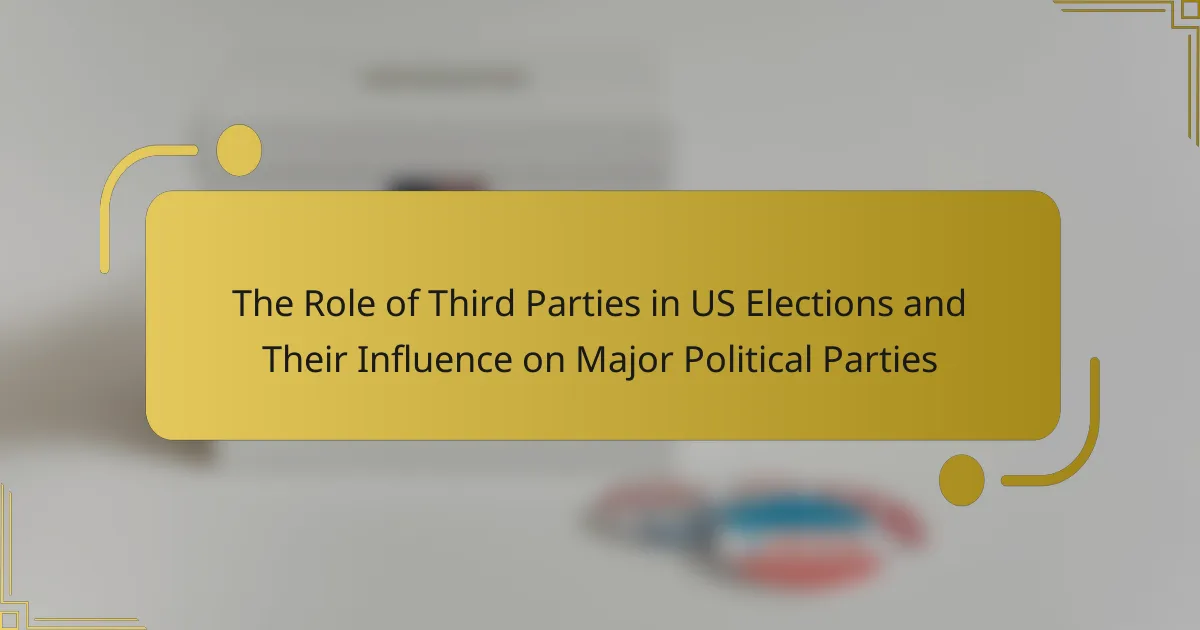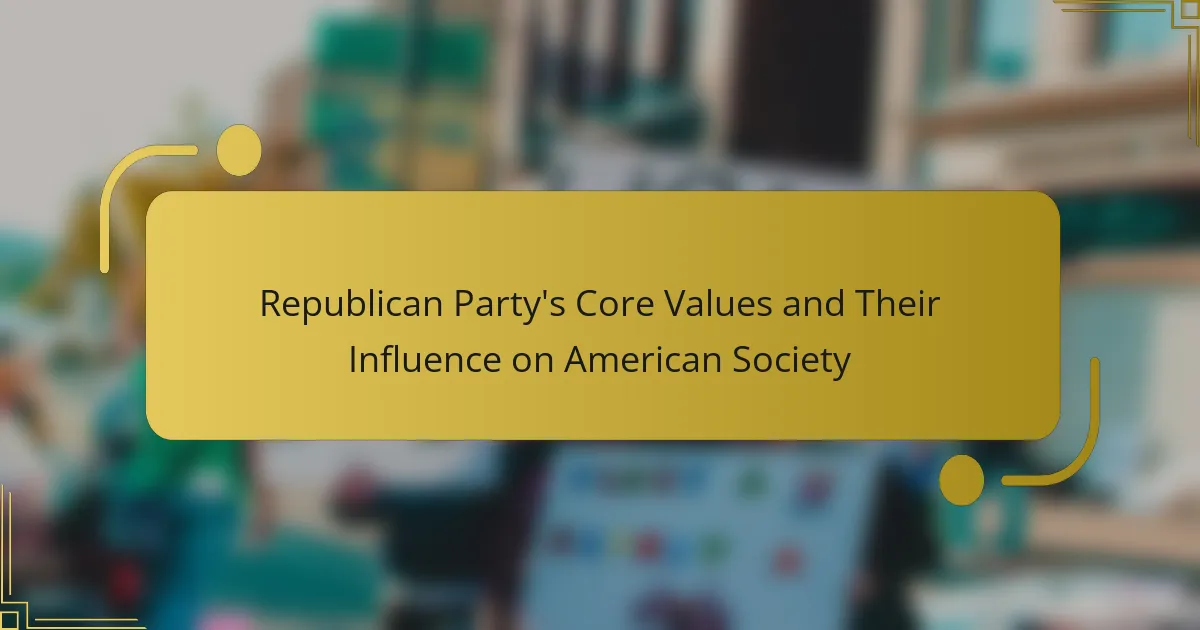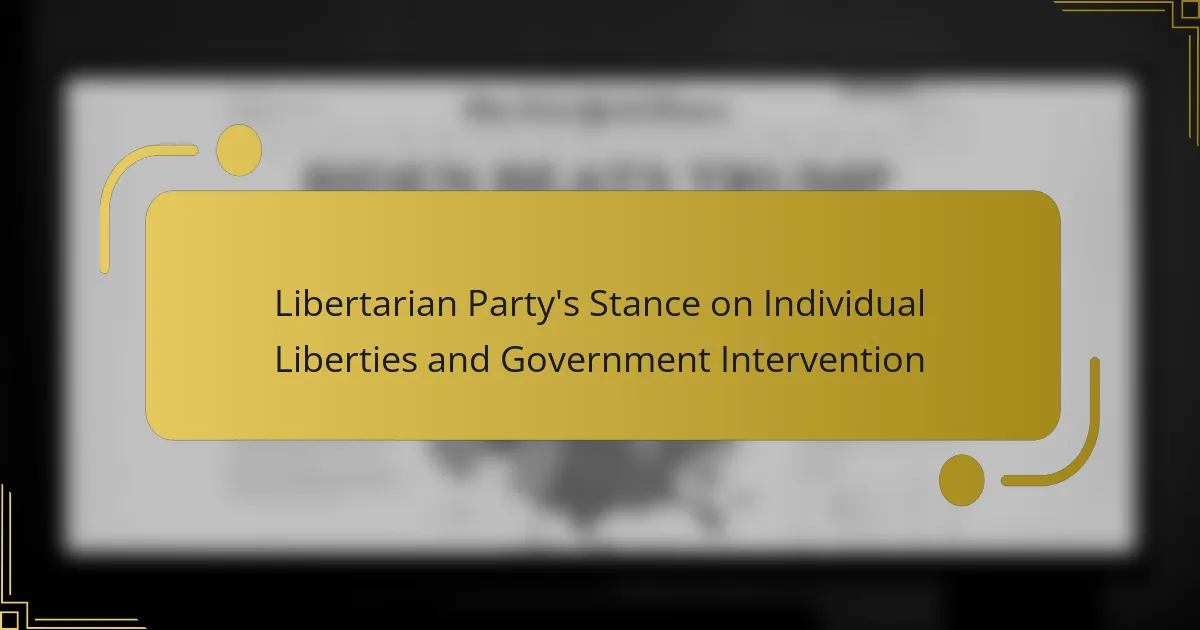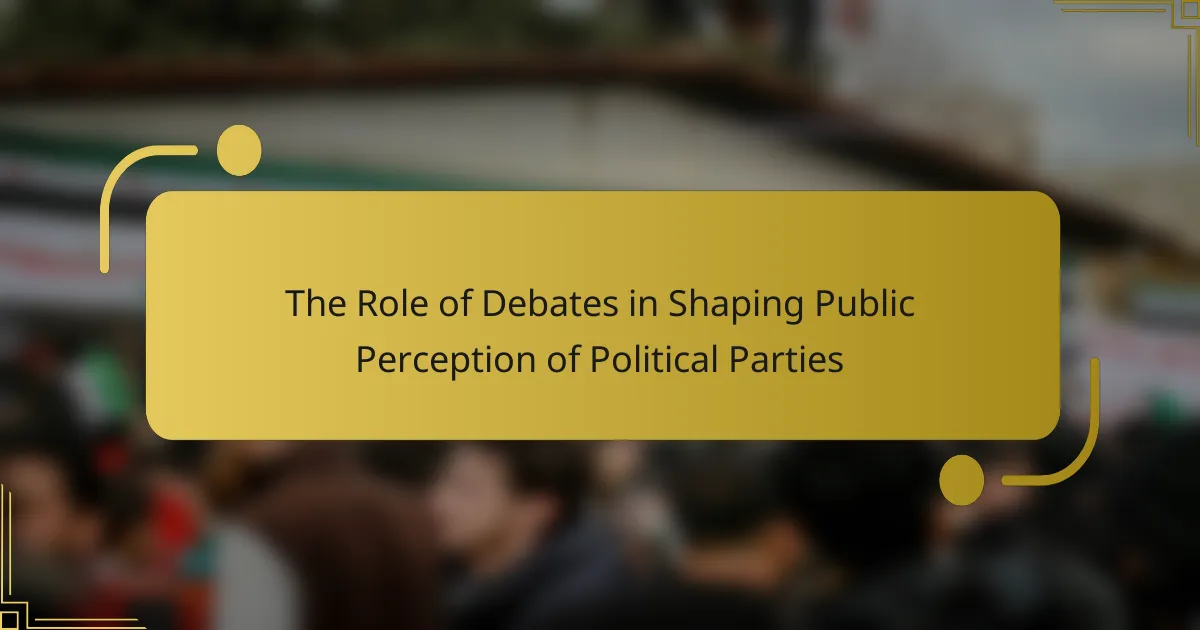Third parties in US elections are alternative political entities that provide voters with options beyond the two dominant parties, the Democrats and Republicans. They can significantly influence election outcomes by siphoning votes from major candidates, especially in tightly contested races. Additionally, third parties introduce new ideas and issues into political discussions and can compel major parties to address specific concerns. Historical examples, such as Ross Perot’s impact in the 1992 election, demonstrate how third parties can affect election dynamics and contribute to a more varied political landscape. This article examines the role of third parties in US elections and their influence on the platforms of major political parties.
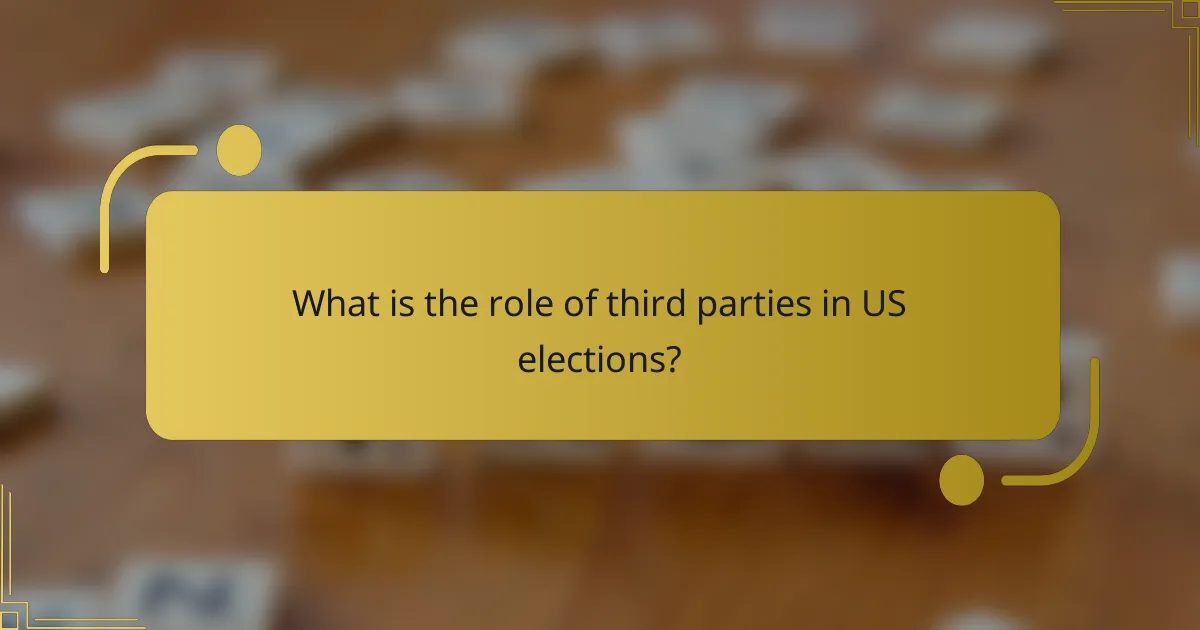
What is the role of third parties in US elections?
Third parties in US elections serve as alternative options to the two dominant political parties. They can influence election outcomes by drawing votes away from major candidates. This is particularly evident in closely contested races. Third parties often introduce new ideas and issues into the political discourse. They can also impact major party platforms by forcing them to address specific concerns. Historical examples include the impact of Ross Perot in the 1992 election. His candidacy is believed to have affected the outcome between George H.W. Bush and Bill Clinton. Overall, third parties contribute to a more diverse political landscape.
How do third parties differ from major political parties?
Third parties differ from major political parties primarily in their size and influence. Major political parties, such as the Democratic and Republican parties, dominate the political landscape in the United States. They have substantial resources, widespread recognition, and significant voter bases. In contrast, third parties often struggle to gain traction due to limited funding and lower visibility.
Third parties typically represent specific ideologies or issues that major parties may overlook. For example, the Green Party emphasizes environmental issues, while the Libertarian Party focuses on individual liberties. Major parties often adapt their platforms in response to third-party movements.
Historically, third parties have had limited success in winning major offices. The last third-party candidate to win a state electoral vote was George Wallace in 1968. Despite this, third parties can influence major party policies and elections by drawing votes away from them. This can affect the outcomes of closely contested races.
What are the defining characteristics of third parties?
Third parties are political organizations that operate independently of the two dominant parties in a political system. They often emerge to represent specific interests or ideologies that are not adequately addressed by major parties. Third parties can influence elections by drawing votes away from major candidates. They may also introduce new ideas and policies into the political discourse. Historically, third parties have played significant roles in shaping major party platforms. For instance, the Progressive Party in the early 20th century influenced the Republican Party’s policies. Additionally, third parties often struggle with gaining ballot access due to stringent election laws. Their limited resources compared to major parties can hinder their visibility and impact.
How do third parties impact voter choice?
Third parties impact voter choice by providing alternative options to the major political parties. They can influence the political landscape by attracting voters dissatisfied with mainstream candidates. This often leads to a shift in voter preferences and priorities. Historical examples include Ross Perot in 1992, who garnered 19% of the popular vote, affecting the outcome between Bill Clinton and George H.W. Bush. Third parties can also bring attention to specific issues that major parties may overlook. They may draw votes away from major party candidates, potentially altering election results. In some cases, this can lead to a major party losing a close race. Overall, third parties serve as a catalyst for change within the electoral process.
Why are third parties significant in the electoral process?
Third parties are significant in the electoral process because they introduce alternative viewpoints and policies. They can influence the major political parties by shifting the political agenda. For instance, third parties often raise issues that are overlooked by the mainstream parties. This was evident in the 1992 election when Ross Perot’s candidacy brought attention to the federal deficit. Additionally, third parties can affect election outcomes by siphoning votes from major candidates. In some cases, this can lead to unexpected victories for one of the major parties. Overall, third parties contribute to a more dynamic and representative political landscape.
What historical examples illustrate third party influence?
The Progressive Party in the early 20th century illustrates third party influence. Founded by Theodore Roosevelt in 1912, it drew support away from the Republican Party. This division helped Democrat Woodrow Wilson win the presidency. The Green Party’s impact in the 2000 election is another example. Ralph Nader’s candidacy is believed to have siphoned votes from Al Gore. This contributed to George W. Bush’s narrow victory in Florida. The Reform Party, established by Ross Perot in 1995, also showcases third party influence. Perot’s campaign focused on fiscal issues and garnered nearly 19% of the vote in 1992. These examples highlight how third parties can affect election outcomes and major party dynamics.
How do third parties affect election outcomes?
Third parties can significantly affect election outcomes by siphoning votes from major party candidates. This can lead to unexpected results, particularly in closely contested races. For example, Ralph Nader’s candidacy in the 2000 presidential election is often cited. Nader, running as a Green Party candidate, is believed to have drawn votes away from Al Gore. This may have contributed to George W. Bush winning the election by a narrow margin in Florida.
Additionally, third parties can influence the political agenda. They often bring attention to issues that major parties may overlook. This can pressure major parties to adopt certain policies to attract voters. In some cases, third parties can also act as a spoiler, preventing a major party from securing a majority.
Statistical analyses show that third-party candidates can impact voter turnout and preferences. Research indicates that in elections where third parties are present, major party candidates may receive fewer votes than expected. This illustrates the tangible influence third parties can exert on election dynamics.
What challenges do third parties face in US elections?
Third parties in US elections face significant challenges that hinder their success. These challenges include limited access to ballot placement. Many states impose strict requirements for third parties to appear on ballots. Additionally, third parties struggle with fundraising compared to major parties. Major parties dominate donor networks and media coverage. Third parties also encounter voter perception issues. Many voters view them as less viable options. This perception is reinforced by the winner-takes-all electoral system. In this system, winning a plurality is crucial, often sidelining third-party candidates. Overall, these factors create a challenging environment for third parties in US elections.
How do electoral laws impact third party participation?
Electoral laws significantly influence third party participation in elections. These laws determine ballot access, funding, and voting systems. Strict ballot access laws can hinder third parties from competing effectively. For example, some states require a high number of signatures for third parties to appear on the ballot. This can limit their visibility to voters. Additionally, funding laws often favor major parties, making it difficult for third parties to raise money. The use of winner-takes-all electoral systems also disadvantages third parties. In such systems, only the candidate with the most votes wins, discouraging voters from supporting third parties. Research indicates that states with proportional representation allow for greater third party success. This shows how electoral laws shape the landscape for third party involvement.
What barriers do third parties encounter in gaining visibility?
Third parties encounter several barriers in gaining visibility. Limited media coverage often restricts their exposure compared to major parties. Major political parties dominate news cycles, overshadowing third-party messages. Funding disparities also play a significant role. Third parties typically have fewer financial resources for advertising and outreach. Voter perception poses another challenge. Many voters view third parties as less viable options, leading to reluctance in supporting them. Additionally, ballot access laws can hinder third-party participation in elections. These laws vary by state and often favor established parties, making it difficult for third parties to compete. Historical trends show that third-party candidates rarely secure significant electoral wins, reinforcing these barriers.
How do third parties influence major political parties?
Third parties influence major political parties by introducing new ideas and platforms. They can shift the political discourse and bring attention to issues that major parties may overlook. For instance, the Green Party has highlighted environmental concerns, prompting major parties to adopt more eco-friendly policies. Additionally, third parties can siphon votes away from major party candidates, affecting election outcomes. In the 2000 presidential election, Ralph Nader’s candidacy is believed to have drawn votes from Al Gore, impacting the final results. This dynamic can force major parties to reconsider their strategies and policies to regain lost support. Overall, third parties serve as a catalyst for change within the political landscape.
What strategies do major parties adopt in response to third parties?
Major parties adopt several strategies in response to third parties. They often try to absorb third-party issues into their platforms. This tactic aims to diminish the appeal of third parties. For example, the Democratic Party has incorporated progressive policies to attract voters from left-leaning third parties.
Another strategy is to discredit third parties. Major parties may label them as spoilers in elections. This approach seeks to undermine their legitimacy and influence. Additionally, major parties can focus on voter mobilization. They aim to ensure their base turns out to vote, countering any potential impact from third parties.
In some cases, major parties may form coalitions with third parties. This strategy can help consolidate votes and strengthen their position. Overall, these strategies reflect the competitive nature of the political landscape in the U.S.
How do third parties shape major parties’ platforms?
Third parties influence major parties’ platforms by introducing new ideas and issues. They often highlight topics that major parties may overlook. This can lead major parties to adopt these issues to attract voters. For example, the Green Party has pushed environmental issues into the mainstream. The impact of the Reform Party in the 1990s shifted focus to government reform. Major parties may also adopt third-party positions to prevent voter loss. This dynamic can reshape campaign strategies and policy priorities. Ultimately, third parties serve as a catalyst for change within the political landscape.
What are the current trends regarding third parties in US elections?
Current trends indicate that third parties are gaining visibility in US elections. Increased voter dissatisfaction with the two major parties is driving this trend. Polls show a growing number of voters identifying as independent. In the 2020 presidential election, third-party candidates received over 5% of the popular vote. This marked the highest percentage since Ross Perot’s campaign in 1996. Additionally, states are adopting ranked-choice voting, which benefits third-party candidates. This voting method allows voters to rank candidates, reducing the fear of wasting votes. Overall, the rise of social media is also helping third parties reach wider audiences.
How have recent elections changed the landscape for third parties?
Recent elections have significantly altered the landscape for third parties in the United States. Increased polarization between major parties has created opportunities for third parties to attract disillusioned voters. In the 2020 election, for instance, the Green Party and Libertarian Party gained visibility, although they still faced challenges in securing significant votes. The rise of independent candidates has also been notable, with some states allowing for more competitive races. Data from the 2022 midterm elections showed that third-party candidates received over 5% of the total votes in several key races. This indicates a growing acceptance of alternative political options among the electorate. Additionally, social media has enabled third parties to reach wider audiences, enhancing their campaign strategies. Overall, recent elections have demonstrated a shift towards a more diverse political landscape, albeit with ongoing barriers for third-party success.
What role do social movements play in the rise of third parties?
Social movements significantly contribute to the rise of third parties. They mobilize public support around specific issues that mainstream parties may overlook. This mobilization creates a demand for alternative political representation. Social movements often articulate new ideas and policies, shaping the agenda for third parties. For example, the Civil Rights Movement influenced the formation of parties focused on social justice. Similarly, environmental movements have led to the emergence of green parties. Historical evidence shows that third parties often gain traction during periods of social upheaval. This connection between social movements and third parties highlights the importance of grassroots advocacy in American politics.
What practical steps can third parties take to increase their influence?
Third parties can increase their influence by building strong grassroots campaigns. Engaging local communities fosters trust and support. They should also focus on clear messaging that resonates with voters’ needs. Utilizing social media effectively can amplify their reach and connect with younger demographics. Forming coalitions with like-minded organizations enhances visibility and credibility. Participating in debates and public forums raises awareness of their platforms. Additionally, collecting and sharing data on voter preferences can inform strategic decisions. Historical examples show that successful third-party campaigns often prioritize these steps to gain traction.
How can third parties effectively engage with voters?
Third parties can effectively engage with voters by utilizing targeted outreach strategies. They should identify key demographics and tailor their messages accordingly. Utilizing social media platforms allows for direct interaction with potential voters. Engaging in community events fosters personal connections and builds trust. Providing clear policy positions helps voters understand their platform. Collaborating with local organizations can expand their reach and credibility. Research indicates that grassroots efforts significantly increase voter awareness and participation. For example, the Green Party’s local initiatives in 2018 increased their voter base by 30% in targeted areas.
What strategies can third parties employ to build coalitions?
Third parties can employ several strategies to build coalitions. They should identify common goals with potential allies. This creates a foundation for collaboration. Third parties must engage in outreach to diverse groups. Effective communication of shared values is essential. They can host forums and discussions to foster dialogue. Building trust through transparency enhances relationships. Additionally, leveraging social media can amplify their message. Historical examples show that successful coalitions often lead to increased electoral influence.
The main entity of this article is third parties in US elections and their influence on major political parties. The article explores the role of third parties as alternative political options, their impact on election outcomes, and how they introduce new ideas into the political discourse. It discusses the differences between third parties and major parties, the challenges third parties face, and historical examples of their influence. Additionally, the article examines current trends, the role of social movements, and practical strategies for third parties to enhance their visibility and voter engagement.
